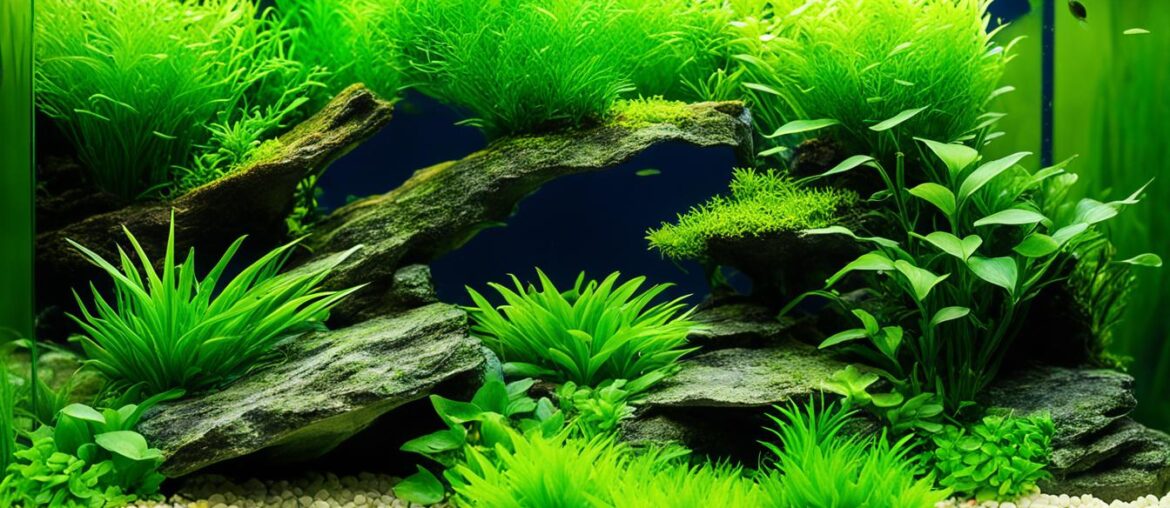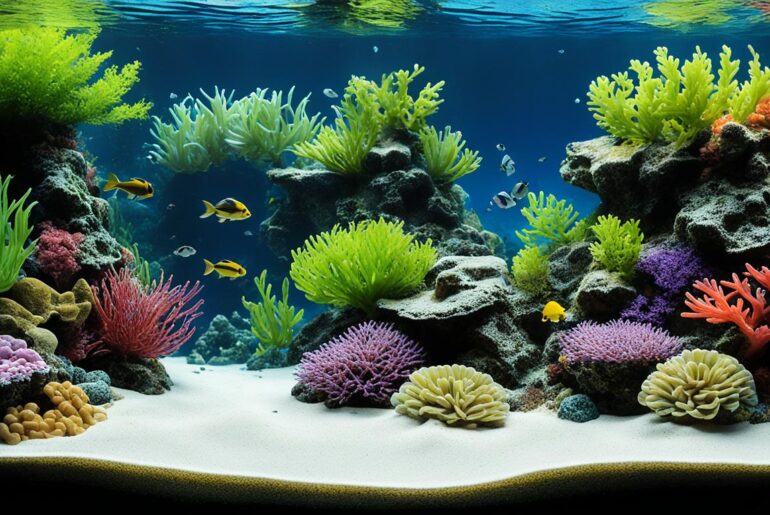It all started with a love for nature and a fascination with aquatic life. I had always wanted to have my own freshwater aquarium, but the limited space in my small apartment made it seem impossible. That was until I discovered the world of freshwater nano tanks. These pint-sized ecosystems allowed me to bring a piece of the underwater world into my home, even with limited space.
As I embarked on my journey to create the perfect freshwater nano tank, I quickly realized that one of the most crucial aspects of tank maintenance was the substrate. The substrate not only provided a foundation for the aquatic plants but also played a vital role in maintaining the overall health and balance of the tank.
With trial and error, I learned the importance of choosing the right substrate and how it can make all the difference in creating a thriving aquatic environment. Through this journey, I have gathered valuable substrate tips and recommendations that I am excited to share with you.
Key Takeaways:
- Choosing the right substrate is essential for the health and success of your freshwater nano tank.
- The substrate provides a foundation for aquatic plants and helps maintain the balance of the tank.
- Proper substrate maintenance is essential for creating an optimal environment for tank inhabitants.
- By following these substrate tips, you can achieve a beautiful and thriving freshwater nano tank.
- Stay tuned for more detailed insights on achieving optimal substrate in nano tanks.
The Importance of Substrate in Nano Tanks
When setting up a nano tank, one crucial element that should not be overlooked is the choice of substrate. The substrate plays a vital role in creating a thriving and balanced environment for your tank inhabitants.
First and foremost, the substrate provides a home for beneficial bacteria. These bacteria play a crucial role in the nitrogen cycle, converting harmful ammonia into less toxic substances, such as nitrite and nitrate. Without a quality substrate, it would be challenging for these bacteria to establish and thrive, leading to poor water quality and potential health issues for your fish and other aquatic creatures. By providing a suitable substrate, you are creating a favorable habitat for the important biological processes that keep your tank healthy.
Another significant benefit of using quality substrate is its ability to support plant growth. Many nano tank enthusiasts enjoy keeping live plants in their tanks for their aesthetic appeal and the additional benefits they provide. A good substrate provides anchorage for the plant roots, allowing them to take hold and grow. Additionally, certain substrates can even provide essential nutrients for the plants, promoting lush and vibrant growth. Not only do live plants enhance the visual appeal of your nano tank, but they also contribute to the overall ecological balance by absorbing excess nutrients and providing oxygen.
“A quality substrate is like a foundation for your nano tank, providing a stable and nurturing environment for both the biological and botanical aspects of your aquatic ecosystem.”
Besides its functional benefits, substrate also plays a role in the aesthetics of your nano tank. With a wide variety of substrates available in different colors, sizes, and textures, you have the opportunity to create a visually captivating tank that reflects your personal style and preferences. Whether you prefer the natural look of sand or gravel, the boldness of colored substrates, or the intricate patterns found in aquasoils, the choice of substrate can make a significant impact on the overall appearance of your nano tank.
With all these factors in mind, it is evident that choosing a quality substrate for your nano tank is crucial for creating a healthy and visually appealing environment. Let’s explore the various types of substrates available and the factors to consider when selecting the right one for your nano tank in the next section.
Things to Consider Before Choosing Substrate
When setting up a nano tank, selecting the right substrate is a crucial decision that can greatly impact the health and success of your aquatic ecosystem. Before making your substrate choice, there are several factors to consider that will help create a balanced and thriving environment for your tank inhabitants.
Filtration:
One important consideration when choosing substrate for a nano tank is the filtration system. The substrate can play a role in biological filtration, where beneficial bacteria colonize the substrate and help break down waste and toxins in the water. It is important to select a substrate that promotes the growth of these beneficial bacteria and enhances the filtration capacity of your tank.
Benefits of Live Plants:
Live plants not only add beauty and natural aesthetics to a nano tank but also provide numerous benefits to the overall ecosystem. They help oxygenate the water, provide hiding spots for shy or smaller tank inhabitants, and absorb excess nutrients, helping to maintain water quality. When choosing a substrate, consider its compatibility with live plants and their root systems.
“Live plants not only add beauty and natural aesthetics to a nano tank but also provide numerous benefits to the overall ecosystem.”
Bio-Load and Tank Inhabitants:
Another crucial factor to consider is the bio-load of your tank inhabitants. Some fish and invertebrates have specific substrate requirements, such as burrowing species that may need a fine sand substrate. It is essential to choose a substrate that meets the needs of your tank inhabitants and supports their natural behaviors and well-being.
By carefully considering these factors, you can select a substrate that complements your tank’s filtration system, supports the growth of live plants, and provides a suitable environment for your preferred tank inhabitants. This thoughtful approach will help create a healthy and balanced nano tank ecosystem that is visually appealing and a joy to maintain.
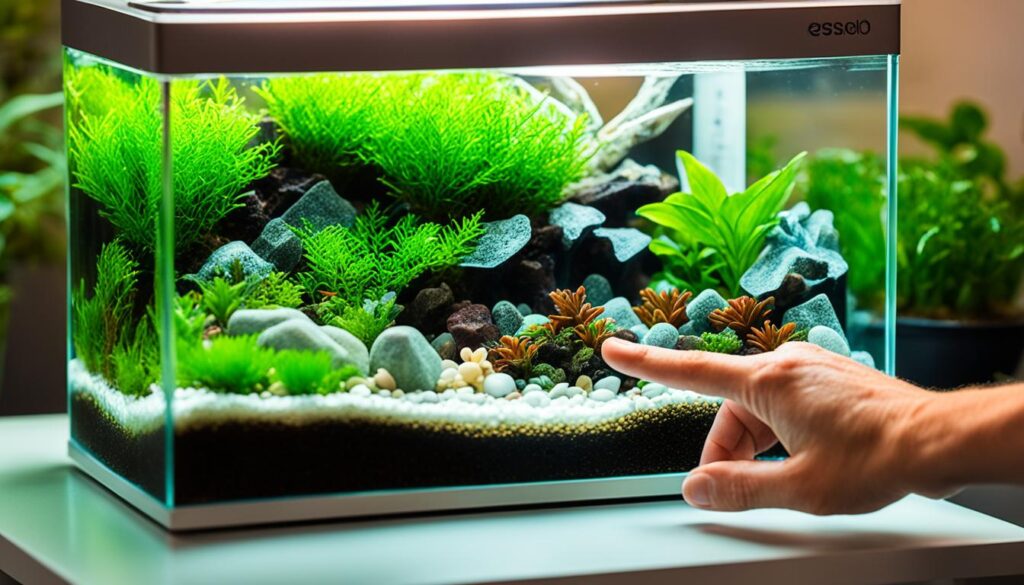
Tips for Proper Nano Aquarium Maintenance
Proper maintenance is crucial for keeping your nano tank in optimal condition. By following these tips, you can ensure the health and longevity of your miniature aquatic ecosystem.
Performing Regular Water Changes
Regular water changes are essential for maintaining a stable and healthy nano tank. Aiming for weekly water changes of 20-30% is recommended for most nano tanks. This helps remove accumulated waste, excess nutrients, and potentially harmful substances from the water.
Testing Water Chemistry
Regularly monitoring the water chemistry in your nano tank is key to detecting any potential issues and taking corrective measures. Test kits for parameters such as pH, ammonia, nitrite, and nitrate levels are essential tools for maintaining a balanced and safe environment for your tank inhabitants.
Monitoring the Tank for Issues
Keeping a close eye on your nano tank is vital for spotting any signs of trouble early on. Look out for changes in behavior or appearance of your fish and plants, as well as any unusual water conditions. Swift action can prevent small issues from escalating into larger problems.
“Water changes and water chemistry tests are the backbone of successful nano tank maintenance. They ensure a stable environment for your aquatic pets and help prevent major problems.”
Creating a Maintenance Routine
Establishing a regular maintenance routine for your nano tank will make it easier to stay on top of tasks. Create a schedule for water changes, testing water chemistry, and other necessary maintenance tasks. Consistency is key to keeping your tank in optimal condition.
Preventing Drastic Changes
Avoid sudden and drastic changes to your nano tank’s environment. Small shifts in water chemistry and temperature can have a significant impact on the delicate balance of the tank. Take measures to acclimate new additions, such as plants or fish, to the tank slowly and gradually.
Essential Maintenance Tasks for Nano Tanks
| Task | Frequency |
|---|---|
| Water changes | Weekly (20-30% of tank volume) |
| Testing water chemistry | Regularly (at least once a week) |
| Monitoring tank health | Daily |
| Algae control | As needed |
| Cleaning equipment | Monthly |
Maintaining a nano tank requires consistent effort, but the rewards are well worth it. By following these maintenance tips, you can create a beautiful and thriving aquatic ecosystem in your mini aquarium.
Letting the Tank Cycle Completely
When setting up a nano tank, it’s important to let the tank cycle completely before adding any livestock. This process allows beneficial bacteria to establish themselves in the tank, ensuring a stable and healthy environment for your aquatic pets. Cycling a nano tank involves creating an ideal environment for the growth of these beneficial bacteria, which play a crucial role in maintaining water quality.
During the cycling process, toxic compounds like ammonia and nitrite are converted into less harmful substances, such as nitrate, by these beneficial bacteria. This creates a balanced ecosystem that can support the bio-load of the tank inhabitants.
Why is cycling important?
Cycling a nano tank provides several benefits:
- Establishing beneficial bacteria: Allowing the tank to cycle completely ensures that the necessary bacteria, such as Nitrosomonas and Nitrobacter, are present in sufficient quantities. These bacteria convert harmful compounds into less toxic forms and provide a stable biological filter in the tank.
- Preventing ammonia spikes: A fully cycled tank helps prevent sudden ammonia spikes, which can be detrimental to the health of your livestock. Ammonia is highly toxic to fish and other aquatic creatures, and cycling the tank helps maintain low ammonia levels.
- Maintaining water quality: Cycled tanks have more stable water parameters, including pH and nitrate levels. This promotes the overall well-being of your tank inhabitants and reduces the risk of stress-related illnesses.
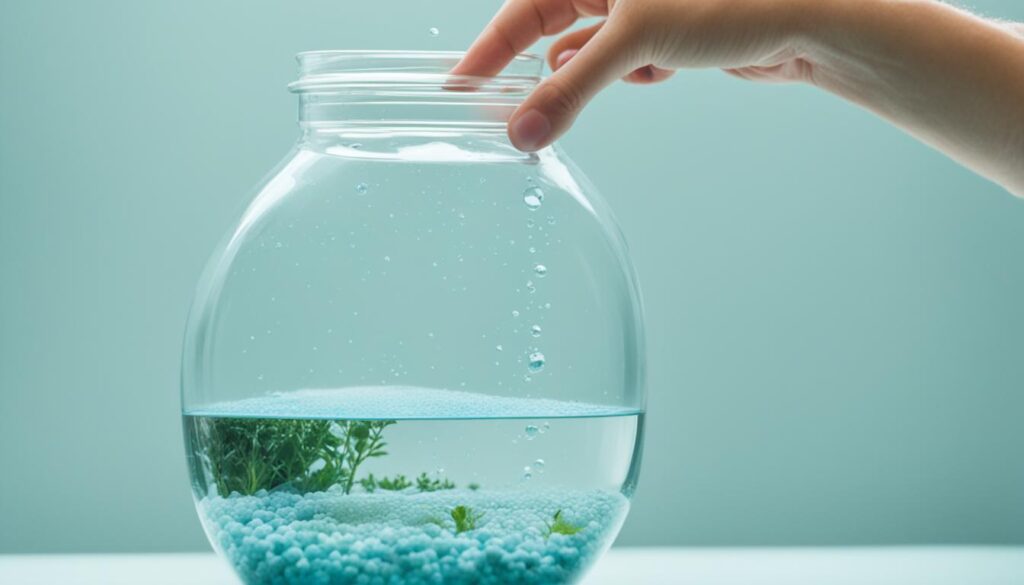
“Cycling a nano tank is like building a solid foundation for a house. It’s the first step toward creating a thriving aquatic ecosystem.” – Chris, experienced aquarium hobbyist
Taking it slow with livestock
Once your nano tank has completed the cycling process, it’s time to introduce your desired livestock. However, it’s important to add them gradually to ensure the tank can handle the increased bio-load. Adding too many fish or invertebrates at once can overwhelm the beneficial bacteria and lead to water quality issues.
Start by adding a small number of hardy fish or invertebrates and monitor their behavior and water parameters closely. This allows the tank to adjust to the new inhabitants and ensures that the beneficial bacteria can handle the waste produced.
After a couple of weeks, if the tank and its inhabitants are stable, you can slowly increase the number and variety of livestock. This gradual approach helps maintain a healthy balance in the tank and minimizes the risk of ammonia spikes or other water quality problems.
Remember, patience is key when it comes to cycling a nano tank and introducing livestock. By allowing the tank to cycle completely and adding livestock slowly, you’ll create a thriving aquatic environment that will bring joy and beauty to your home.
Choosing the Right Filter Media
In a nano tank, selecting the proper filter media is of utmost importance to maintain water quality and promote the well-being of tank inhabitants. One essential aspect of filter media is its ability to facilitate biological filtration. Biological filtration is the process by which beneficial bacteria break down harmful substances, such as ammonia and nitrite, into less toxic compounds, promoting a healthy tank environment.
When choosing filter media for a nano tank, it is crucial to opt for those with excellent biological filtration capabilities. These media types serve as a home for beneficial bacteria, allowing them to proliferate and effectively remove harmful substances. Proper biological filtration helps create a stable and healthy ecosystem in the tank, supporting the overall health and well-being of the aquatic life within it.
There are various filter media options available in the market for nano tanks, each with its own advantages and suitability. Some popular choices include:
- Biological filter pads
- Bio-balls or ceramic rings
- Sponge filters
It is essential to consider the specific needs of the tank and its inhabitants when selecting filter media. Different media types vary in their effectiveness, maintenance requirements, and compatibility with different filter systems. Consulting with experienced aquarists or seeking advice from reputable aquarium stores can help in making an informed decision.
“The health of a nano tank heavily depends on the quality of the filter media chosen. With the right biological filtration capabilities, the filter media helps maintain water quality and provides a thriving environment for aquatic life.”
Investing in high-quality filter media is a worthwhile step to ensure optimal water conditions and the well-being of the tank’s inhabitants. By facilitating biological filtration, the selected filter media helps keep harmful substances in check, reducing the risk of stress, disease, and tank imbalances. A well-maintained filter system enhances the overall health and longevity of a nano tank, making it a rewarding hobby for any aquarist.
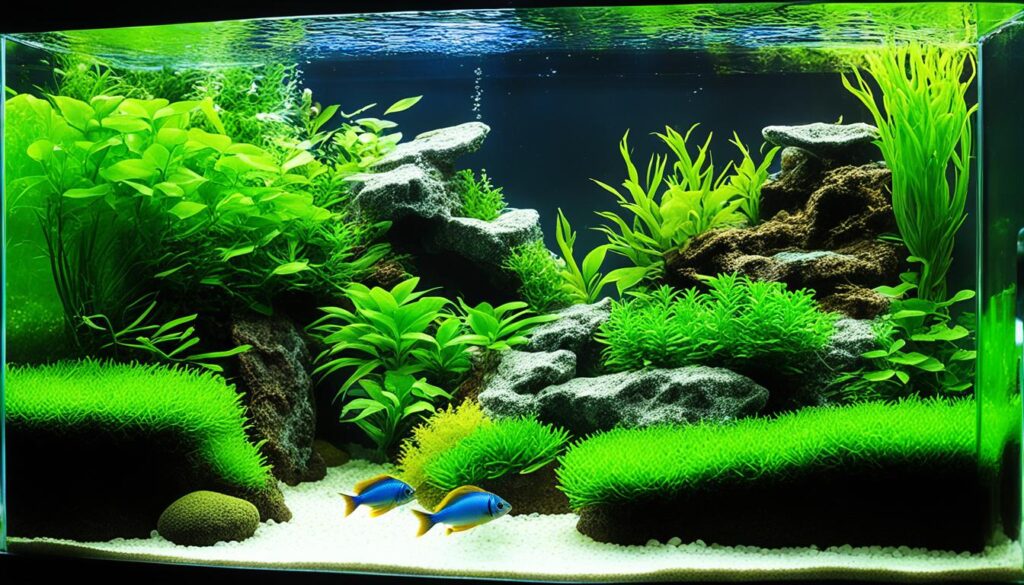
Pros and Cons of Different Filter Media Types
| Filter Media Type | Pros | Cons |
|---|---|---|
| Biological Filter Pads |
|
|
| Bio-Balls or Ceramic Rings |
|
|
| Sponge Filters |
|
|
Performing Regular Water Changes and Substrate Maintenance
Regular water changes and proper substrate maintenance are vital for the health and cleanliness of your freshwater nano tank. By incorporating these maintenance tasks into your routine, you can ensure the longevity and well-being of your tank inhabitants.
I recommend performing weekly water changes in your nano tank. This helps maintain water quality by removing accumulated toxins, excess nutrients, and waste. Additionally, larger volumes of water changes are often advised for nano tanks to minimize the risk of water chemistry fluctuations.
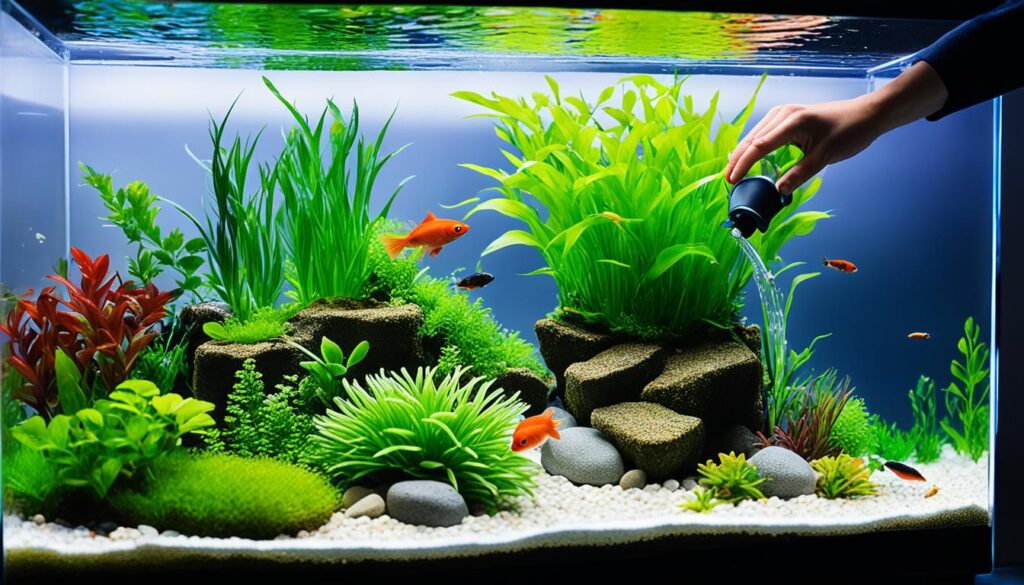
In addition to water changes, it’s essential to siphon the substrate regularly. Siphoning involves using a small tube or siphon to remove debris, detritus, and uneaten food from the substrate. This action helps keep the substrate clean and prevents the accumulation of waste that could compromise water quality. However, take care not to disturb any live plants or disrupt the substrate while siphoning.
“Performing regular water changes and substrate maintenance is key to keeping your nano tank clean and your aquatic ecosystem thriving.”
By regularly performing water changes and siphoning the substrate, you can create an optimal environment in your nano tank, promoting the well-being and health of your tank inhabitants. Maintaining a clean substrate and pristine water quality contributes to the overall aesthetics and functionality of your mini aquarium.
Benefits of Regular Water Changes and Substrate Maintenance:
- Removes toxins, excess nutrients, and waste
- Maintains stable water chemistry
- Prevents the accumulation of detritus
- Supports the overall health and well-being of tank inhabitants
Proper Siphoning Technique:
- Use a small tube or siphon specifically designed for aquarium use.
- Place one end of the siphon into a bucket or suitable container.
- Carefully submerge the other end of the siphon into the substrate.
- Using your mouth or a manual pump, create suction to start the flow of water.
- Gently move the siphon throughout the substrate, making sure not to disturb plants or disrupt the substrate.
- Continue siphoning until you’ve removed the desired amount of debris.
- Dispose of the collected water and debris appropriately.
Regular water changes and substrate maintenance are simple yet critical tasks in caring for your nano tank. By incorporating these practices into your aquarium maintenance routine, you can ensure a clean, healthy, and thriving aquatic environment for your beloved tank inhabitants.
Testing Water Chemistry and Monitoring Changes
Regularly testing the water chemistry in a nano tank is essential for maintaining a healthy and stable environment for your aquatic inhabitants. By monitoring parameters such as pH, ammonia, and nitrite levels, you can detect any changes or potential issues early on and take appropriate measures to address them.
Testing the water parameters in your nano tank allows you to assess the overall water quality and ensure that it meets the specific needs of your fish, plants, and other tank inhabitants. Imbalances in pH levels, high ammonia or nitrite levels, or other chemical fluctuations can have detrimental effects on the well-being of your aquatic ecosystem.
The Importance of Monitoring Water Chemistry
Monitoring water chemistry in your nano tank not only helps you identify potential problems, but it also enables you to take proactive steps to maintain optimal conditions. By regularly testing and monitoring water parameters, you can:
- Ensure a stable and suitable pH level for your tank inhabitants.
- Prevent and address high ammonia and nitrite levels that can be toxic to fish.
- Detect any signs of water pollution or contaminants.
- Make informed decisions about water changes and necessary adjustments.
By staying vigilant and proactive in monitoring your water chemistry, you can create a safe and thriving environment for your nano tank.
Testing Water Parameters in Nano Tanks
There are several methods available for testing water parameters in nano tanks. One common approach is to use water test kits that are specifically designed to measure pH, ammonia, nitrite, and other essential parameters. These test kits typically come with detailed instructions for accurate and reliable testing.
When conducting water tests, it’s important to follow the instructions carefully and perform the tests at regular intervals. This allows you to track any changes over time and detect fluctuations that may require adjustments to your tank’s maintenance routine.
Here are a few key water parameters you should monitor in your nano tank:
- pH: The pH level indicates the acidity or alkalinity of the water. Different species of fish and plants have different pH preferences, so it’s important to maintain a suitable pH range for your specific tank inhabitants.
- Ammonia: Ammonia is highly toxic to fish and can rapidly accumulate in the tank if not properly managed. Regular testing helps ensure that ammonia levels remain within safe limits.
- Nitrite: Nitrite is another harmful substance that can accumulate in an improperly cycled tank. Monitoring nitrite levels allows you to identify potential issues and take corrective measures.
- Other parameters such as nitrate, temperature, and hardness may also be relevant depending on your specific tank setup and inhabitants.
I highly recommend investing in a reliable water test kit and making regular testing a part of your maintenance routine. It’s an essential tool for keeping your nano tank healthy and providing the best possible environment for your aquatic friends.
Understanding and monitoring water chemistry in your nano tank is crucial for ensuring the well-being and longevity of your aquatic ecosystem. By regularly testing water parameters and addressing any imbalances or concerns, you can maintain a thriving and vibrant nano tank.
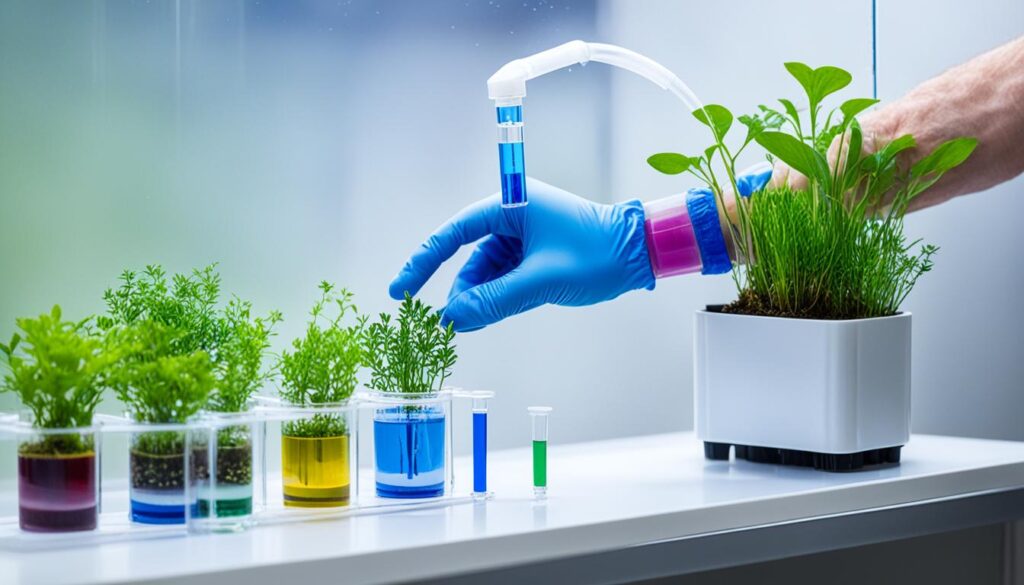
Checking and Maintaining Aquarium Equipment
Regularly checking and maintaining aquarium equipment is vital for the health and stability of your nano tank. Malfunctioning filters or heaters can have detrimental effects on the well-being of your tank inhabitants, so it’s important to keep a close eye on their performance and address any issues promptly.
One of the most crucial pieces of equipment to monitor is your filter. Filters play a significant role in maintaining water quality by removing organic waste and debris from the tank. Ensure that the filter is running smoothly and efficiently, providing adequate mechanical and biological filtration. Clean or replace filter media as needed to avoid clogging, which can impede water flow and compromise the filtration process.
Similarly, it’s essential to regularly inspect and maintain your heater to ensure a stable and consistent temperature in your nano tank. Check the heater’s thermostat to verify that it’s set to the desired temperature and accurately reading the water temperature. Clean the heater and remove any accumulated sediment or debris that can interfere with its performance.
Remember, both the filter and heater are critical components of your tank’s ecosystem. Faulty equipment can lead to temperature fluctuations, inadequate filtration, and reduced oxygen levels, potentially harming your fish and other tank inhabitants.
Take the time to visually inspect all equipment for signs of wear or damage. Look for cracks, leaks, or loose connections that could lead to malfunctions or accidents. Additionally, pay attention to any unusual noises or vibrations emitted by the equipment, as they may indicate mechanical issues that require attention.
Regular maintenance tasks include rinsing filter sponges or cartridges, descaling equipment, and replacing worn-out parts. It’s recommended to follow the manufacturer’s instructions for specific maintenance procedures to ensure optimal performance and longevity of your equipment.
Quick Tips for Checking and Maintaining Aquarium Equipment:
- Inspect the filter and heater regularly for any visible damage or leaks.
- Verify that the filter is providing adequate mechanical and biological filtration.
- Ensure the heater is maintaining a stable and accurate temperature.
- Clean or replace filter media as needed to prevent clogging.
- Remove sediment or debris from the heater to improve its performance.
- Follow manufacturer’s instructions for maintenance tasks and replacement parts.
By regularly checking and maintaining your aquarium equipment, you can create a stable and healthy environment for your nano tank inhabitants, ensuring their well-being and enhancing your overall enjoyment of your miniature aquatic world.
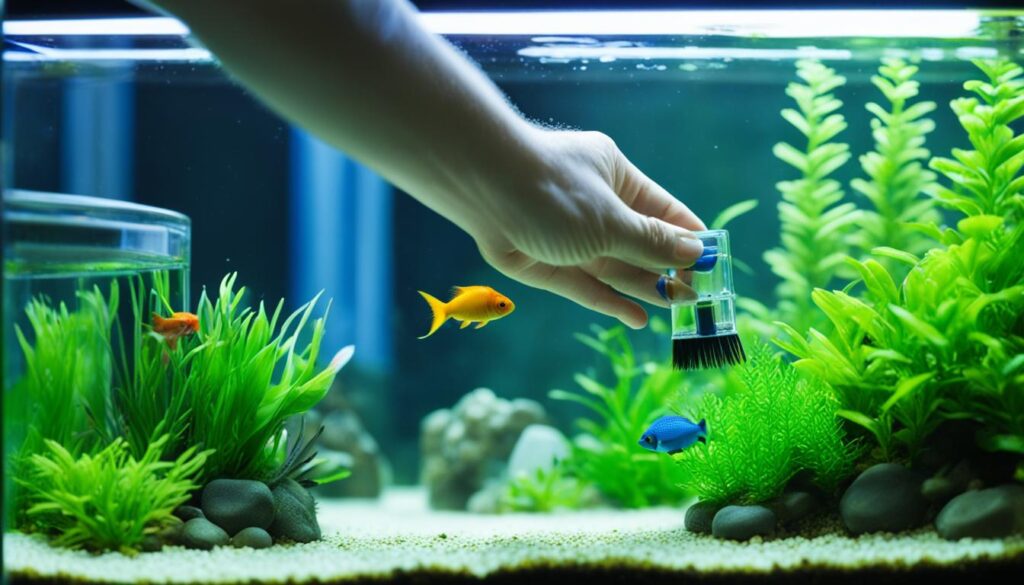
Understanding the Types of Aquarium Substrates
When setting up a nano tank, one of the key considerations is choosing the right type of substrate. There are several options available, including inert substrates like gravel and sand, as well as aquasoils. Each type has its own characteristics and benefits, which can greatly impact the health and aesthetics of your aquarium.
Inert Substrates: Gravel and Sand
Gravel and sand are commonly used as inert substrates in aquariums. They do not alter the water chemistry and primarily serve as a decorative element. Gravel is available in various colors and sizes, allowing for customization and creativity in designing your tank. It provides good water circulation and acts as a substrate for plants, helping them anchor their roots.
Sand, on the other hand, offers a more natural look and provides a soft, smooth substrate for bottom-dwelling fish. Some species of fish, such as corydoras catfish, prefer sand as it does not irritate their delicate barbels.
Both gravel and sand should be rinsed thoroughly before adding them to your tank to remove any dust or debris that might cloud the water. Regular vacuuming of the substrate during water changes helps maintain cleanliness and prevents waste buildup.
Aquasoils: The Nutrient-Rich Substrate
Aquasoils, also known as planted tank substrates, are specifically designed to provide essential nutrients for aquatic plants. These substrates are made from volcanic soil and are rich in minerals and trace elements. They create an environment that promotes healthy plant growth and enhances the overall aesthetics of a planted aquarium.
The main advantage of aquasoils is their ability to release nutrients gradually over time. This helps nourish the plants and promotes strong root development. Aquasoils also contribute to maintaining stable water parameters by buffering the pH and absorbing excess ammonia, reducing the risk of harmful spikes.
It is important to note that aquasoils can release ammonia during the initial setup phase, which can be harmful to fish and other livestock. It is recommended to cycle the tank with plants or perform frequent water changes to mitigate any potential ammonia spikes.
Comparison of Inert Substrates and Aquasoils
To better understand the differences between inert substrates and aquasoils, let’s compare them based on important factors:
| Factors | Inert Substrates (Gravel/Sand) | Aquasoils |
|---|---|---|
| Water Chemistry | No impact | Buffer pH, absorb excess ammonia |
| Plant Growth | Requires additional fertilization | Provides essential nutrients for plants |
| Aesthetics | Customizable colors and sizes | Enhances the natural look |
| Bottom-Dwelling Fish | Can be abrasive for delicate barbels | Soft and gentle substrate for bottom-dwellers |
Note: This table is a visual representation of the key differences between inert substrates (gravel/sand) and aquasoils.
By considering these factors, you can make an informed decision when selecting the most suitable substrate for your nano tank. Whether you prefer the versatility of inert substrates or the nutrient-rich benefits of aquasoils, the right choice will contribute to a thriving and visually appealing aquarium.
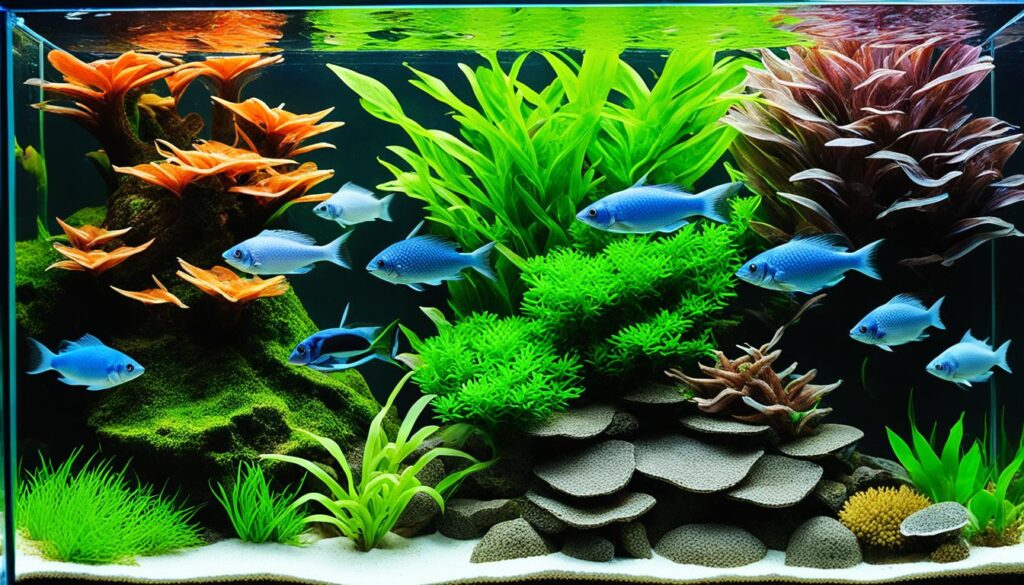
Choosing the Right Substrate for Your Nano Tank
When it comes to selecting a substrate for your nano tank, there are several important considerations to keep in mind. The right substrate can make a significant difference in terms of plant growth, tank aesthetics, and water parameters. Let’s explore some key factors to keep in mind when choosing the perfect substrate for your nano tank.
Considerations for Plant Growth
If you plan to have live plants in your nano tank, it’s crucial to select a substrate that supports their growth and development. Some substrates, such as aquasoils, are specifically designed to provide essential nutrients to plants, promoting healthy root development and vibrant foliage. These nutrient-rich substrates can help create a thriving planted nano tank ecosystem.
Pro Tip: Aquasoils like Nature’s Own Aqua Soil or Fluval Plant and Shrimp Stratum are highly recommended for planted nano tanks, as they release beneficial minerals over time and provide a fertile base for aquatic plants.
On the other hand, if you prefer a more minimalist approach or want to create a sandy beach-like environment, a substrate like sand can be an excellent choice. While sand doesn’t offer the same nutrient benefits as aquasoils, it can enhance the overall appearance of the tank and provide a natural-looking habitat for certain fish and invertebrates.
Considerations for Aesthetics
Aside from plant growth, the aesthetics of your nano tank are essential for creating an appealing visual display. The choice of substrate can play a significant role in achieving the desired tank aesthetics. Consider the color, texture, and grain size of the substrate to complement the overall design of your tank.
Pro Tip: For a sleek and modern look, consider using a black or white sand substrate like CaribSea Super Naturals or Estes Marine Sand Black. These substrates provide a clean and polished appearance, allowing your fish and plants to stand out in the tank.
Considerations for Water Parameters
Another crucial aspect to consider when choosing a substrate is its impact on water parameters. Different substrates can affect the pH and hardness of the water to varying degrees. It’s important to select a substrate that aligns with the specific requirements of the fish and plants in your nano tank. If you have sensitive species that prefer acidic or soft water, selecting a substrate that buffers the pH or releases minerals can help create the optimal conditions for their well-being.
When it comes to planted nano tanks, aquasoils excel at providing stable and slightly acidic conditions, which are preferred by many popular aquarium plant species. However, it’s important to monitor and adjust water parameters regularly to ensure they are within the desired range for your tank inhabitants.

| Substrate Type | Advantages | Disadvantages |
|---|---|---|
| Aquasoils | Provides essential nutrients for plant growth, buffers pH, supports a thriving planted tank ecosystem | Can be costly, needs regular water parameter monitoring and adjustment |
| Sand | Enhances tank aesthetics, suitable for certain fish and invertebrates, easy to clean | Does not provide significant nutrients for plants, may require additional fertilization |
Remember, the choice of substrate for your nano tank ultimately depends on your specific goals and preferences. By considering factors such as plant growth, aesthetics, and the impact on water parameters, you can confidently choose a substrate that will create a beautiful, healthy, and thriving nano tank ecosystem.
Conclusion
Proper substrate maintenance is essential for the health and success of a freshwater nano tank. By following the substrate tips outlined in this article, you can create an optimal substrate environment that promotes the well-being of your tank inhabitants and enhances the overall beauty of your mini aquarium.
Choosing the right substrate for your nano tank and considering factors such as filtration, live plants, and bio-load can significantly contribute to the tank’s overall balance and ecosystem. Regular maintenance, including performing water changes, testing water chemistry, and checking and maintaining aquarium equipment, is crucial for ensuring the stability and longevity of your tank.
With proper planning and maintenance, your freshwater nano tank can thrive and provide endless enjoyment. So, take the time to invest in the right substrate, follow the tips provided in this article, and create a beautiful and thriving home for your aquatic pets!
FAQ
What is the importance of substrate in nano tanks?
The substrate in a nano tank provides a home for beneficial bacteria, supports plant growth, and enhances the aesthetics of the tank. Quality substrate is crucial for maintaining water chemistry and creating a healthy environment for tank inhabitants.
What factors should be considered before choosing substrate for a nano tank?
Factors such as filtration, inclusion of live plants, and the bio-load of the tank inhabitants should be considered before selecting a substrate. These factors ensure that the substrate is suitable for maintaining the tank’s balance and supporting the desired ecosystem.
What are some tips for proper nano aquarium maintenance?
Proper maintenance includes performing regular water changes, testing water chemistry, and monitoring the tank for signs of issues. Regular maintenance routines help maintain stable water chemistry and prevent problems caused by small shifts in the tank’s environment.
Why is it important to let a nano tank complete its cycling process before adding livestock?
Allowing the tank to complete its cycling process ensures that the beneficial bacteria are established and can handle the bio-load of the tank inhabitants. Gradually adding livestock helps maintain water quality and prevent ammonia spikes.
How important is choosing the right filter media for a nano tank?
Selecting the proper filter media, especially ones with good biological filtration capabilities, is essential for maintaining water quality and removing harmful substances in a nano tank.
How should water changes and substrate maintenance be done in a nano tank?
Regular and larger volume water changes are crucial for nano tanks. Siphoning detritus from the substrate is also important to remove waste and maintain tank cleanliness. Care should be taken to avoid disrupting plants and disturbing the substrate.
Why is testing water chemistry and monitoring changes important in a nano tank?
Regularly testing water parameters such as pH, ammonia, and nitrite levels helps ensure the health and stability of a nano tank. It allows for early detection of any changes or potential issues that need to be addressed.
Why is it important to check and maintain aquarium equipment in a nano tank?
Checking and maintaining aquarium equipment, such as filters and heaters, is vital for the health and stability of a nano tank. Malfunctioning equipment can be detrimental to tank inhabitants, so it’s important to address any issues promptly.
What are the types of aquarium substrates available for nano tanks?
There are various types of aquarium substrates, including inert substrates like gravel and sand, as well as aquasoils. Each type has its own characteristics and benefits, which can be considered when selecting a substrate for a nano tank.
How can one choose the right substrate for a nano tank?
When choosing a substrate, factors such as plant growth, aesthetics, and water parameters should be considered. Some substrates are especially beneficial for planted tanks, while others enhance the overall appearance of the tank.
